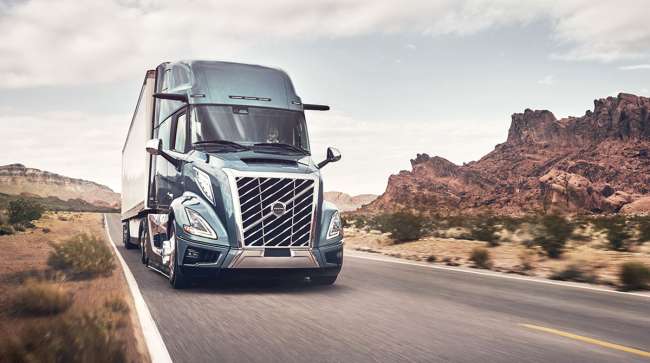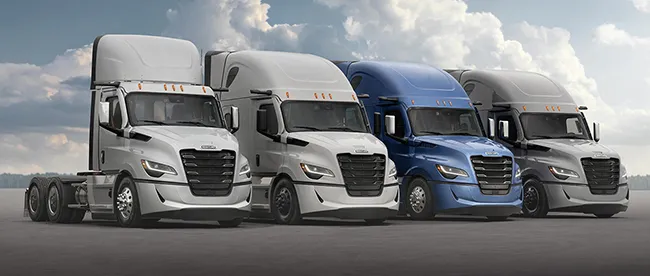Staff Reporter
Truck Makers Gear Up for Second-Half Start to Pre-Buy

[Stay on top of transportation news: Get TTNews in your inbox.]
Orders for new Class 8 tractors were on the rise as 2024 ended, but an anticipated rush among fleets to “pre-buy” new trucks before stricter federal emissions standards are due to take effect has, so far, not taken hold.
The possibility of a rollback of federal emissions regulations from the Trump administration further clouds the outlook.
U.S. Environmental Protection Agency rules currently on the books will require model year 2027 heavy-duty trucks to emit no more than 0.035 gram of nitrogen oxides per horsepower hour, and industry watchers warn the advancements required to achieve these numbers could add as much as $20,000 to $30,000 to the sticker price of new semis. As a result, carriers are expected to ramp up purchasing of model 2025 and 2026 trucks. This pre-buy — for which a 2024 kickoff had been predicted by some — has been stymied by a frustratingly weak freight environment and, now, possible policy changes from the White House.
“Earlier this year, we were very convinced the pre-buy was going to start this year,” Magnus Koeck, vice president of strategy, marketing and brand management at Volvo Trucks North America, told Transport Topics in an interview in late December. Now he’s looking toward the back half of 2025. “I think we will see an uptick midyear,” said Koeck. “A year from now will look very different from today.”

Koeck
North American Class 8 truck orders jumped in December compared with the same month a year earlier, according to ACT Research, the first such increase since May. Preliminary Class 8 net orders totaled 36,500 trucks, a jump of 39% year over year, the research and analysis firm said. Orders typically increase in the final quarter of the calendar year.
“Class 8 industry orders have been relatively strong the past few months,” said Justina Morosin Batchelor, International Motors’ senior vice president of sales and field operations. “However, the freight market remains under pressure. At this point, these orders appear to be the result of natural demand and not of a pre-buy.”
She also anticipates that pre-buy movement won’t accelerate until later in the year.
“We expect the majority of any pre-buy activity to ramp up in the second half of 2025 and continue through 2026 as the freight market continues to recover and customers’ financials recover,” Morosin Batchelor said

Treinen
Greg Treinen, Daimler Truck North America vice president of on-highway market development, marketing and strategy, echoed that stance, telling TT: “We continue to anticipate extended pre-buy activities starting later in 2025 and through 2026 due to the EPA 27 NOx regulations.”
He noted, however, that it remains to be seen if the upcoming regulations spur activity for zero-emission vehicles.
“Original equipment manufacturers and key industry suppliers may adopt different approaches to upcoming emission regulation changes,” Treinen said. “It is still too early to precisely quantify the impact this may have on the total industry in 2025 and 2026.”
In a late-December blog post, ACT President Kenny Vieth said he expects Class 8 truck orders to stabilize, particularly in vocational segments. Demand related to government-funded infrastructure projects should remain resilient, he added.

Morosin Batchelor
Morosin Batchelor concurs. “We expect the vocational market to continue its strong demand as infrastructure and construction activities remain strong,” she told TT.
International rolled out an integrated powertrain comprising the company’s S13 engine line and T14 automated manual transmission for heavy-duty trucks as well as a September redesign for its HV vocational models over the past 12 months in advance of the pre-buy.
Meanwhile, VTNA and DTNA debuted revamped flagship Class 8 tractors in 2024 with the launches of, respectively, the new Volvo VNL and Freightliner Cascadia models in January and October.
Series production of the redesigned VNL began in October. .
Fellow Volvo Group unit Mack Trucks, meanwhile, plans to launch a new flagship on-highway semi this year, company President Stephen Roy said in November.
Series production of Freightliner’s fifth-generation Cascadia — the first revamp in five years — is scheduled to begin in mid-2025, DTNA said.
Carriers’ optimism about the year is growing too, which is a positive for truck makers.
Old Dominion Freight Line CEO Marty Freeman wrote in a Jan. 6 blog: “We believe 2025 will be defined not just by growth but by prosperity. The foundation for success has been laid, and we’re here to move forward together.”
ODFL ranks No. 8 on the Transport Topics Top 100 list of the largest for-hire carriers in North America.

All four fifth-generation Freightliner Cascadia configurations. (Daimler Truck North America)
And American Trucking Associations’ annual freight forecast, released Jan. 16, said truck volumes are expected to grow 1.6% in 2025.
Freeman’s peers also are optimistic, according to Truckstop’s latest Carrier Insight Survey, released Jan. 8.
Some 94% of the respondents in a survey of nearly 500 carriers believe their professional life will improve in 2025, with 53% expecting it to be “significantly better,” Truckstop said. In addition, 77% of carriers plan to make rig upgrades in 2025.
Chicagoland is often one of the first areas to see growth, Koeck said, but market watchers should also keep an eye on Dallas, Atlanta and Los Angeles.
When exactly pre-buy purchasing starts to advance through the gears will depend heavily on how the U.S. economy performs, according to executives and analysts.
Freight rates remain weak, and expectations for contract rate increases in 2025 are easing.
Truck Parking Club's Evan Shelley discusses how innovative platforms are turning available space into opportunities for reserved parking. Tune in above or by going to RoadSigns.ttnews.com.
What happens in Washington continues to be a wild card, with at least one market watcher seeing the probable introduction of tariffs disrupting carrier equipment purchase plans.
President Donald Trump on the campaign trail promised tariffs as high as 25% on all U.S. imports from Mexico and Canada and an additional 10% tariff on all goods imported from China.
“Currently, more than 40% of Class 8 trucks built for the U.S. are manufactured in Mexico, making these tariffs a potential disruptor to supply chains and production costs and compounding the cost impacts of EPA 2027 NOx regulations,” FTR Transportation Intelligence Senior Analyst for Commercial Vehicles Dan Moyer said in an email.
“In response, fleets may modify their order and retail purchase strategies in the coming months or quarters,” Moyer added.
Truck makers are doing what they can to account for such variables, according to one executive.
“As our industry has learned over the last several years, the only thing to expect is the unexpected. Our production and logistics team monitors the supply chain closely to try and stay ahead of any possible disruptions,” said International’s Morosin Batchelor.
Want more news? Listen to today's daily briefing above or go here for more info
International last year had to work through a difficult supply chain interruption due to a mirror shortage from a supplier in Mexico, which hurt sales dramatically. Plus, International was not the only truck OEM to be affected by that particular disruption.
Despite the order slowdown, VTNA’s Koeck said carriers shouldn’t wait too long if they want to pre-buy equipment before the EPA rules take hold.
“It is a risk that production spots for 2026 will be done very early,” he said. “Customers can place orders with good confidence, but if you order a truck in March 2026 and expect delivery in November 2026, it will not happen.”





